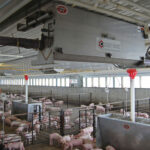Uncovering the Hesston Story: Lyle Yost
For 65 years, this rural burg on the eastern edge of the Great Prairie has been home to a brand that shares its name and is fertile ground for the development of game-changing agricultural machines. During the Dust Bowl years,...
Uncovering the Hesston Story: Lyle Yost
For 65 years, this rural burg on the eastern edge of the Great Prairie has been home to a brand that shares its name and is fertile ground for the development of game-changing agricultural machines. During the Dust Bowl years,...For 65 years, this rural burg on the eastern edge of the Great Prairie has been home to a brand that shares its name and is fertile ground for the development of game-changing agricultural machines.

Lyle Yost
During the Dust Bowl years, a “hill” on an otherwise flat stretch of the Great Prairie was often a piece of farm machinery buried by the era’s black blizzards of blowing topsoil, then deserted due to a hole in the social fabric called the Great Depression. Folks did what they could to survive, and a young Kansan named Lyle Yost helped make ends meet by scouring the countryside around his family’s farm for these mounds of dirt and steel.
“He was as young as 14,” says his daughter Susan, “and as soon as Dad learned how to drive, he would take the truck out into the countryside and look for [abandoned] farm equipment.” Yost, who passed away last year, would excavate what he found and bring it home, where he and his father would use it for spare parts or repair it for sale. “Not only did Dad learn how to build and rebuild [farm equipment], but he got acquainted with farmers,” Susan says. “He learned from them and found out what they needed. The idea of Hesston Corp. was planted when he was a teenager. I don’t think he knew the direction, but he knew that he had a calling, which was to help farmers.”
That direction became clear years later when he took on a problem that afflicted practically every farmer and harvester who owned a combine back in the day. Unloading just took too much time. Yost’s contemporaries used shovels and gravity to get the grain out of the bin, losing valuable time to get the grain up and out of harm’s way.
Yost, however, had an idea for a better way to move that grain, and after a particularly difficult harvest in 1947 and with memories of Dust Bowl storms still fresh, he and blacksmith Adin Holdeman went to work developing his unloading auger design. They made five of them in about a month, Susan recalls, and sent Yost’s cousin Earl Burner out to sell them. “He got back in 3 hours and said he needed 10 more.”
When they returned to the harvest the next summer using their new machine, others witnessed the speed at which the augers unloaded grain, and orders began arriving from as far as Texas and North Dakota. Buoyed by that success, the three men set up an assembly line near their homes in Hesston, and Hesston Manufacturing was born.
More than a half-century later, Yost’s focus on farmer-oriented solutions lives on today. Still located in the small, rural town where it all started, the Hesston facility has gone on to develop some of the most productive machines in agriculture, with the harvesting equipment made there now being sold worldwide.
Read the full story at http://www.myfarmlife.com/advantage/uncovering-the-hesston-story/.



